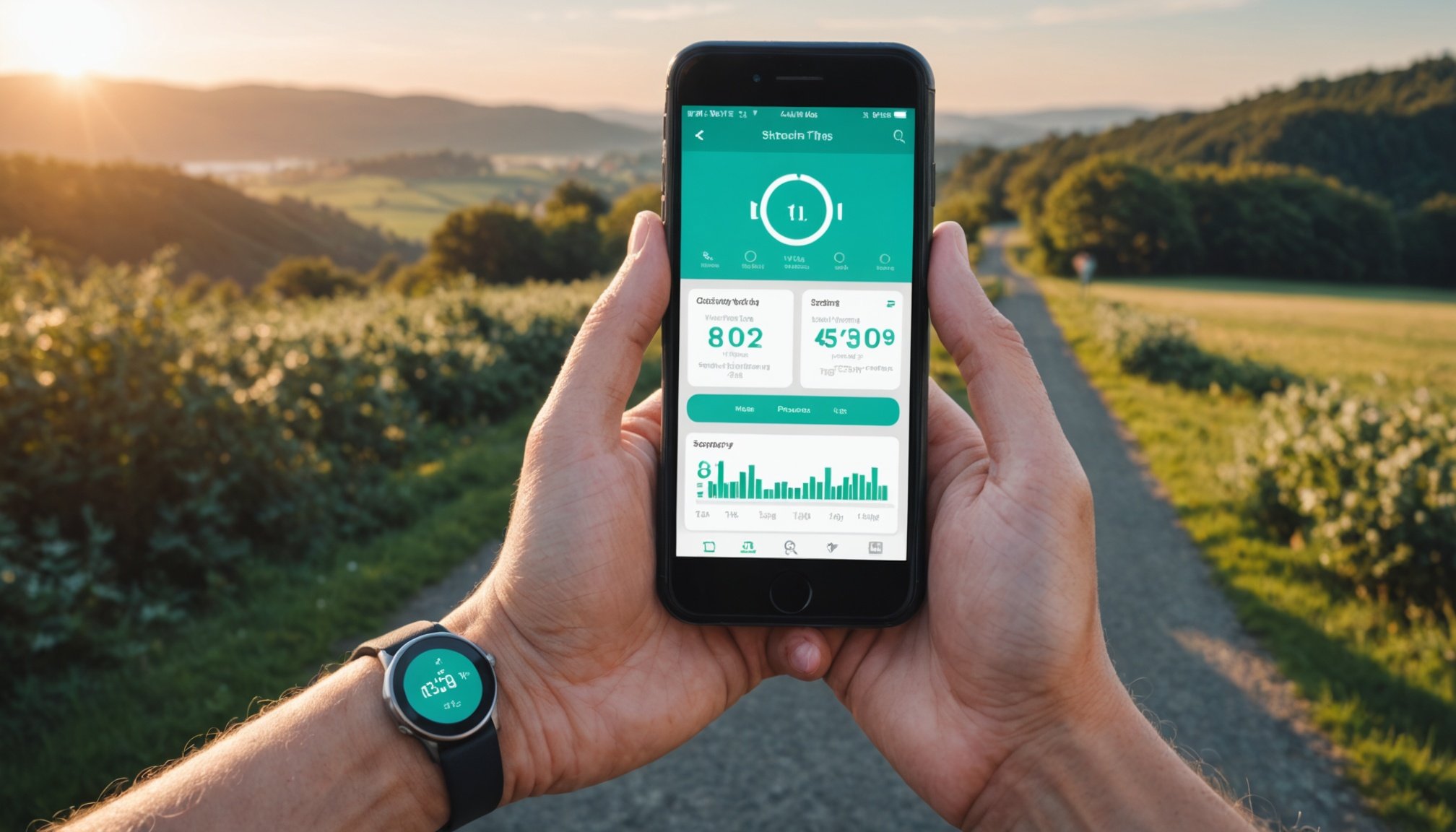Understanding Fitness Trackers and Their Benefits
Fitness trackers have become a popular choice for those looking to optimize their health using wearable devices. These gadgets provide a comprehensive overview of one’s daily activities by tracking movements, heart rate, and even sleep patterns. This data collection allows users to gain insights into their health habits, ultimately helping them make informed decisions about their well-being.
The key benefits of fitness trackers lie in their ability to deliver precise health metrics which aid in improving fitness outcomes. With real-time tracking, users can monitor their physical activity and adjust their routines as necessary. This information empowers individuals to push beyond their limits, setting the stage for enhanced physical and mental health.
Have you seen this : What are the Latest Health Innovations Emerging in the UK?
Moreover, the integration of health technology into daily routines promotes a proactive approach to fitness. By consistently wearing these devices, users gain access to trends and patterns in their lifestyle that might go unnoticed. This capacity for continuous data analysis supports users in identifying areas for improvement, creating a holistic understanding of their fitness journey.
Accurate data collection is crucial; without it, the effectiveness of these trackers diminishes. Reliable metrics foster goal achievement and offer clear pathways to success, ultimately enhancing the overall user experience and yielding better fitness tracker benefits.
Additional reading : Revolutionize Your Fitness: How Outdoor Boot Camps Transform Physical Health
Setting Realistic Goals with Your Fitness Tracker
Setting realistic goals is pivotal in maximizing the effectiveness of fitness trackers. Achieving fitness objectives starts with adopting SMART goals: Specific, Measurable, Achievable, Relevant, and Time-bound. This approach ensures that your goals are clear and focused, facilitating a sense of accomplishment once these benchmarks are met.
Fitness trackers play a crucial role in goal setting by providing accurate data and insights. With this information, users can set achievable objectives tailored to their current fitness levels and desired outcomes. For example, tracking metrics such as daily steps, heart rate, and calorie burn can help create personalised workout routines that align with individual needs.
Adjusting goals based on performance tracking is essential. As users monitor their progress over time, they may need to adapt their objectives to reflect improvements or challenges. This adaptability encourages continuous growth and development, keeping the fitness journey both challenging and rewarding. Receiving feedback from your tracker allows for informed modifications to goals, optimising the path to success.
By aligning goal-setting strategies with the performance data offered by your fitness tracker, you create a tailored fitness plan. This intelligent use of technology makes achieving your fitness dreams not only possible but also enjoyable.
Interpreting Fitness Tracker Data
Understanding and effectively using data from your fitness tracker involves grasping the health metrics it offers. Key metrics like steps counted, heart rate, and calories burned provide insight into your daily activity levels. Realising their significance helps interpret what your body needs to improve or maintain its fitness levels.
Understanding Key Metrics
Fitness trackers measure various metrics, each with its own importance. Step counts indicate daily activity, while heart rate tracks cardiovascular health. Monitoring calories burnt helps manage weight. Each metric plays a role in tailoring your fitness routines to align with your health goals.
Analyzing Trends Over Time
Tracking these metrics over time uncovers patterns that assist in making informed health decisions. Observing trends, such as week-by-week step increases or fluctuations in heart rate, can guide adjustments. Whether increasing intensity or identifying recovery needs, these trends are invaluable for optimising health.
Utilizing Data for Motivation
Fitness tracker data can fuel motivation by highlighting progress and potential improvements. Seeing tangible results keeps enthusiasm high—be it a daily step milestone or a consistent heart rate improvement. Staying focused on these metrics facilitates a rewarding and engaging fitness journey.
Troubleshooting Common Fitness Tracker Issues
Ensuring that your fitness tracker runs smoothly involves understanding common fitness tracker problems and learning effective troubleshooting techniques. Routine device maintenance is also vital in prolonging the lifespan and accuracy of your wearable.
Common Malfunctions and Solutions
Fitness trackers can sometimes experience issues such as inaccurate data collection, syncing problems, or unexpected shutdowns. Address these by performing a reset, ensuring software is up-to-date, and checking settings for potential misconfigurations. Cleaning the sensors and ensuring that the device is securely worn can also help maintain reliable performance.
Maintaining Accuracy and Battery Life
To ensure data accuracy, routinely calibrate the device, particularly after software updates. Regularly check for firmware updates to enhance both functionality and precision. To extend battery life, adjust brightness settings and limit background features when not in use.
When to Seek Professional Help
If problems persist after applying basic troubleshooting steps, it might be time to contact professional support or seek a replacement. Issues such as persistent data inaccuracies or frequent system crashes warrant expert intervention. Knowing when to seek help can save time and ensure you continue benefiting from fitness tracker benefits effectively.
Integrating Fitness Trackers with Other Health Practices
Fitness trackers offer a unique advantage when it comes to creating a holistic health plan. By seamlessly merging technology with lifestyle habits, users can optimise different areas of their well-being. Integrating fitness tracking with nutrition and hydration practices strengthens a healthy lifestyle. Fitness trackers can remind users to drink water and monitor calorie intake, helping balance caloric expenditure and consumption.
The importance of sleep tracking cannot be overstated. Adequate rest is essential for recovery and performance. Fitness trackers often feature sleep analysis, identifying patterns and suggesting improvements. Better sleep enhances not only overall physical health but also mental clarity and mood.
Fitness integration extends to mindfulness and stress management. Incorporating stress-reducing techniques such as meditation or yoga aids physical routines. Fitness trackers can support this by offering reminders and stress level tracking. Understanding stress responses allows for adjusting workouts accordingly, ensuring maximum benefit.
The holistic approach uses the multifaceted data available through fitness trackers to enhance various health avenues. Whether it’s nutrition, sleep, or stress, each aspect plays a crucial role in overall health. Using wearables equips individuals with the tools required to make informed choices, leading to well-rounded and sustained lifestyle improvements.
Staying Motivated with Your Fitness Tracker
Keeping your motivation high while using a fitness tracker involves implementing effective motivation strategies. Acknowledging achievements, no matter how small, enhances performance improvement by keeping you inspired. Recognise milestones such as personal bests or consistent usage to maintain momentum. This habitual recognition aids in sustaining long-term engagement with your tracker.
Techniques to Enhance Engagement
Integrating your fitness tracker seamlessly into your routine encourages regular usage. Customise goals and notifications to suit your lifestyle, ensuring engagement feels natural rather than burdensome. Tracker engagement increases when the device adapts to your needs, offering timely reminders for activity or hydration, supported by insights from data analytics.
Community Support and Accountability
Joining online fitness communities or local groups can amplify your commitment. Sharing progress fosters a sense of collective purpose, while community challenges can invigorate your motivation. Being accountable to others can significantly impact adherence to goals, enhancing both individual and group dynamics.
Competitions and Challenges
Participating in competitions with friends or within fitness apps introduces a fun, competitive element. Set challenges such as step counts or activity minutes to not only push your limits but also enjoy the camaraderie. These interactive features of many fitness applications keep enthusiasm alive and drive continuous self-improvement.

